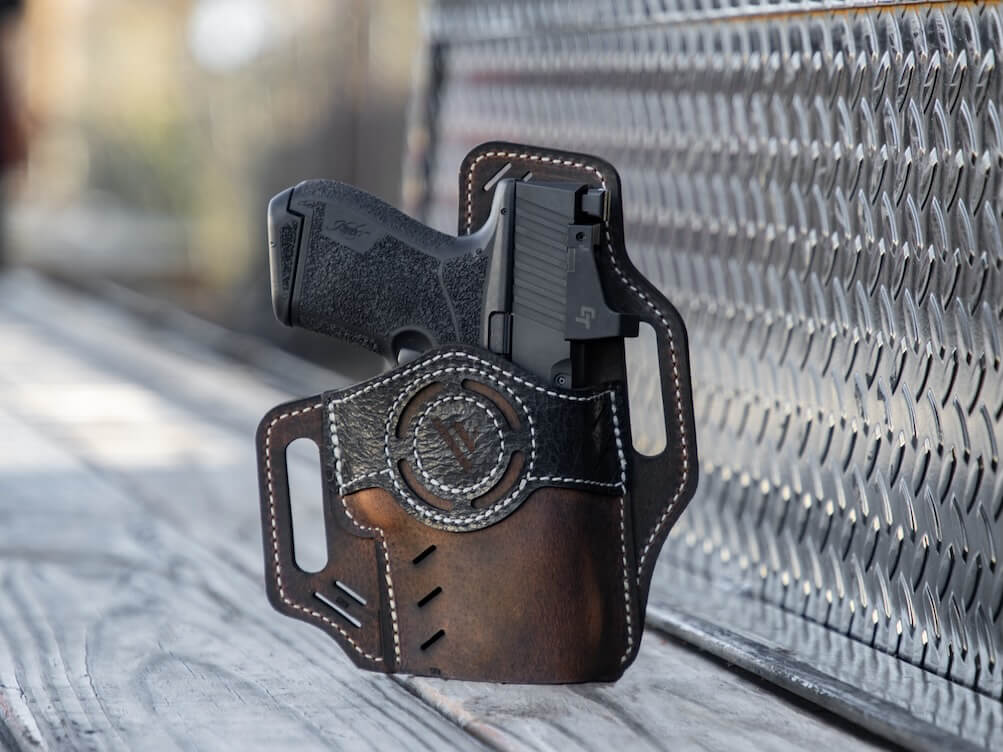The SIG P365 stands out in the world of compact firearms, well-regarded for its capacity and concealability. However, for many shooters, the recoil of this small yet powerful pistol presents a challenge. Recoil, the backward movement experienced when a gun is fired, is an important factor for shooters to consider, as it affects both accuracy and the overall comfort during shooting sessions. Managing the kickback effectively ensures that shots remain consistent, a key element for both self-defense purposes and for sport shooting accuracy.
Within this article, we will explore the unique characteristics of the SIG P365 that contribute to its particular recoil experience. Despite its compact size, the gun is equipped with features that can affect the shooter’s ability to control and predict the weapon’s behavior after each shot, such as a SIG P365 slide. We aim to provide practical techniques and insights that will assist shooters in mastering recoil management. By understanding how to harness and adapt to the recoil of the P365, shooters can improve their shooting performance and enjoy a more comfortable experience with this popular firearm.
Source: Unsplash
Table of Contents
Ergonomics and Recoil: Evaluating the SIG Sauer P365
The SIG Sauer P365 has become a standout option in the compact firearm market, thanks in no small part to its well-considered ergonomic design, which significantly aids in recoil management. The pistol showcases a grip tailored to fit comfortably in diverse hand sizes, ensuring shooters can sustain a firm and steady grasp. The grip’s shape is intended to encourage a natural positioning of the hand, which supports consistent and precise shot placement. To maintain a solid grip even under challenging conditions, the grip texture of the P365 is optimized to supply necessary traction without being harsh to the touch.
What’s more, the firearm’s mass—a careful compromise between light enough for convenient carry and sufficient weight to mitigate some firing impact—influences the perceived recoil. A gun with more heft naturally diminishes the sensation of recoil, as its bulk helps to offset the energy of the departing projectile. Users benefit from a more controlled shooting encounter, which could lead to quicker successive shots. These ergonomic elements of the P365 collectively forge a weapon that is not just agreeable to hold but also more manageable during rapid discharge. This ensures that the firearm maintains its status as a steadfast option for both individual defense and law enforcement use.
The Engineering Behind the Punch: Understanding the Mechanics of the P365’s Recoil
When firing a SIG P365, the design decisions behind its functioning greatly affect the weapon’s recoil behavior. This compact firearm is thoughtfully constructed to control the kick that accompanies each shot. Internally, the P365 employs a weight-reduced slide and a deliberately tuned barrel length, each playing a key role in the perception of recoil by the user. A lighter slide means there’s less mass moving back and forth as the gun cycles, potentially resulting in a more abrupt recoil than might be felt with a heavier slide. Barrel length also impacts the firearm’s equilibrium and the forces exerted during discharge—the more extended the barrel, the greater the weight at the front, which may decrease muzzle rise.
The P365’s firing system, including the striker and recoil spring assembly, interacts to moderate the recoil impulse. The way these components work together also determines the distribution of energy from the expelled cartridge through the weapon and into the shooter’s grip. Detailed engineering is applied to ensure that the P365 not only functions dependably but also offers a controllable recoil experience within its small stature.
Effective Recoil Control Strategies for P365 Users
Mastering recoil control is important for P365 users who want to enhance their precision and comfort during firing drills. A correct hold and body posture are the primary components for reducing the weapon’s kick. For the P365, enthusiasts should concentrate on maintaining a strong yet adaptable hold, making sure the webbing between the thumb and index finger is positioned high on the backstrap of the handgun. This positioning improves command over the firearm. At the same time, arranging the feet at the width of the shoulders, with knees lightly flexed and the body’s mass leaning into the shot, can provide a robust base that better accommodates recoil.
Techniques like the “push-pull” method, in which the firing hand propels the firearm forwards while the supporting hand pulls backwards, can further contribute to stability and recoil management. In addition, executing controlled trigger presses and consistent follow-through are techniques that, when diligently practiced, will build a shooter’s automatic response in managing the P365’s recoil with time. Incorporating these methods into habitual training will noticeably improve a shooter’s capacity to operate their P365.
Enhancing the P365 with Aftermarket Accessories
The aftermarket sector for firearms is abundant with parts and accessories aimed at personalizing and improving your shooting experience, especially when it comes to recoil management. One handgun that benefits from such enhancements is the P365. Owners of this popular firearm can find an extensive selection of aftermarket products designed to tame the kick. Recoil springs and guide rods are at the core of these modifications. Upgrading to a sturdier recoil spring can reduce the snappiness of the P365, while a new guide rod can add weight, aiding in steadying the gun during shots.
Grip enhancements offer a more ergonomic hold, allowing for better control and a reduction in perceived recoil. These modifications not only make shooting more comfortable but can also improve accuracy. However, shooters should carefully consider these options, as every change could potentially affect the firearm’s balance, aesthetics, and even reliability. It’s necessary to weigh the benefits against any trade-offs and to choose accessories that are compatible with your specific shooting style and P365 model.
Ammunition Choices and Their Impact on Recoil
When selecting ammunition for a firearm like the SIG Sauer P365, it’s vital to understand how different loadings can influence the gun’s recoil profile. Ammunition comes in many calibers and loads, altering recoil intensity. High-powered, heavier rounds usually produce more recoil, which can impact shooting accuracy and comfort.
For those seeking balance between stopping power and controllability, it’s important to choose mid-range ammunition that provides reliable performance without overwhelming recoil. It’s also beneficial to consider different bullet weights and designs, as these can also modify recoil and the shooting experience. Ultimately, when picking practice or carrying ammunition, shooters must contemplate the trade-offs. The aim is to select a round that ensures sufficient defensive capabilities while still allowing for manageable and consistent recoil, guaranteeing that each shot can be made accurately and with confidence.
After exploring the ins and outs of recoil management for the SIG P365, it’s evident that a firm grasp on this compact firearm can enhance your shooting performance greatly. We’ve covered key tips like establishing a strong grip, adopting a balanced stance, and incorporating adequate arm support to tame the kick. We’ve also discussed the value of dry-fire practice and live-fire drills to engrain these techniques into muscle memory. Now, it’s up to you to apply these strategies consistently. The road to mastery isn’t always smooth, but with perseverance, you can transform the initial challenges of handling recoil into a testament to your skill and adaptability.
The post Steadying the Kick: Taming the Recoil of the SIG P365 for Enhanced Shooting appeared first on Top Entrepreneurs Podcast | Enterprise Podcast Network.



Leave a Reply